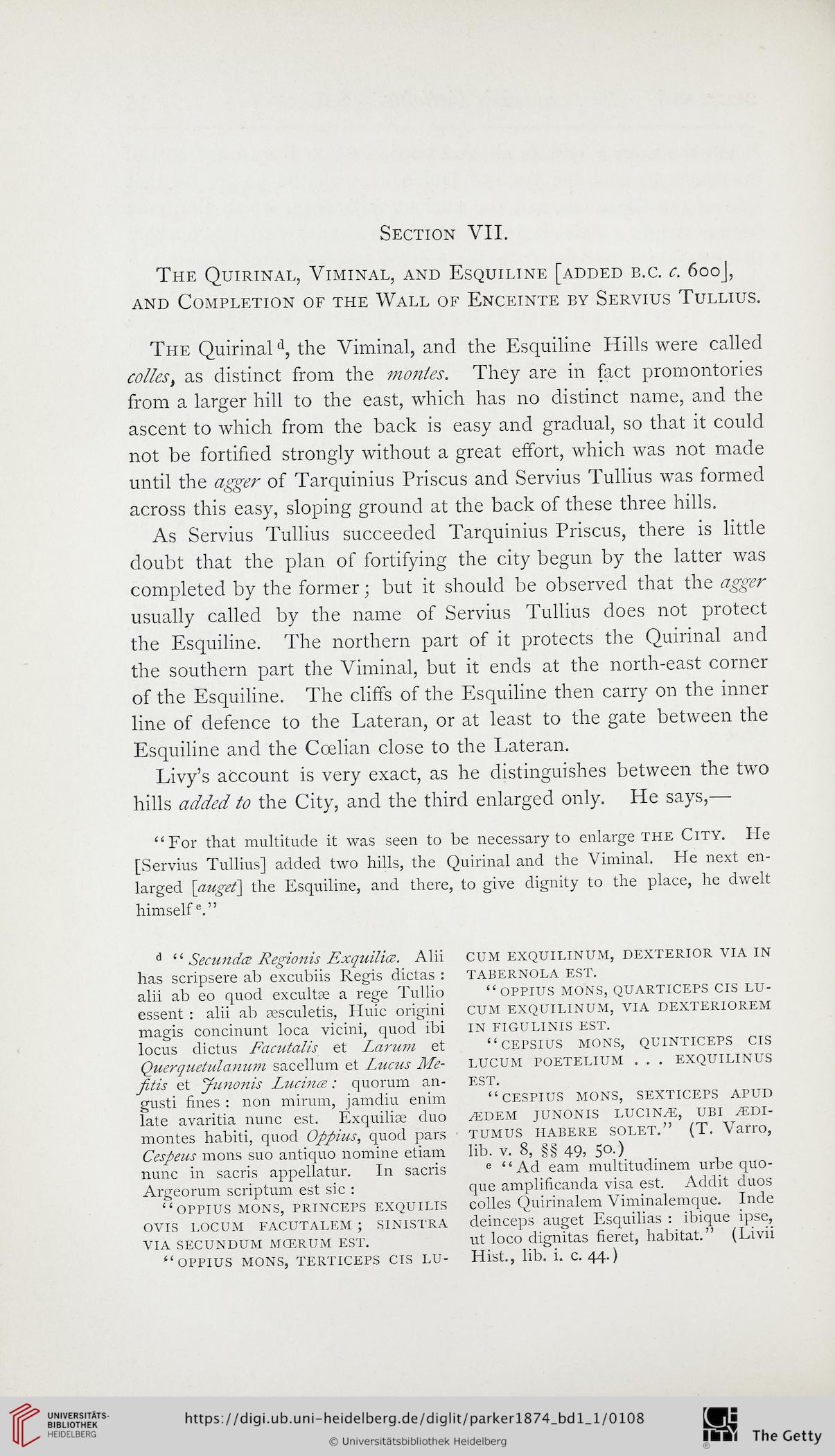Section VII.
The Quirinal, Viminal, and Esquiline [added b.c. c. 600J,
and Completion of the Wall of Enceinte by Servius Tullius.
The Quirinald, the Viminal, and the Esquiline Hills were called
colies, as distinct from the monies. They are in fact promontories
from a larger hill to the east, which has no distinct name, and the
ascent to which from the back is easy and gradual, so that it could
not be fortified strongly without a great effort, which was not made
until the agger of Tarquinius Priscus and Servius Tullius was formed
across this easy, sloping ground at the back of these three hills.
As Servius Tullius succeeded Tarquinius Priscus, there is little
doubt that the plan of fortifying the city begun by the latter was
completed by the former; but it should be observed that the agger
usually called by the name of Servius Tullius does not protect
the Esquiline. The northern part of it protects the Quirinal and
the southern part the Viminal, but it ends at the north-east corner
of the Esquiline. The cliffs of the Esquiline then carry on the inner
line of defence to the Lateran, or at least to the gate between the
Esquiline and the Coelian close to the Lateran.
Livy’s account is very exact, as he distinguishes between the two
hills added to the City, and the third enlarged only. He says,—
“For that multitude it was seen to be necessary to enlarge the City. He
[Servius Tullius] added two hills, the Quirinal and the Viminal. He next en-
larged \auget\ the Esquiline, and there, to give dignity to the place, he dwelt
himself8.”
d ‘ ‘ Secunda Regionis Exquilia. Alii
has scripsere ab excubiis Regis dictas :
alii ab eo quod excultae a rege Tullio
essent : alii ab aesculetis, Huie origini
magis concinunt loca vicini, quod ibi
locus dictus Facutalis et Larum et
Querquetulanum sacellum et Lucus Me-
fitis et Junonis Lucince: quorum an-
gusti fines : non mirum, jamdiu enim
late avaritia nunc est. Exquiliee duo
montes habiti, quod Oppius, quod pars
Cespeus mons suo antiquo nomine etiam
nunc in sacris appellatur. In sacris
Argeorum scriptum est sic :
“ OPPIUS MONS, PRINCEPS EXQUILIS
OVIS LOCUM FACUTALEM ; SINISTRA
VIA SECUNDUM M.CERUM EST.
“ OPPIUS MONS, TERTICEPS CIS LU-
CUM EXQUILINUM, DEXTERIOR VIA IN
TABERNOLA EST.
“OPPIUS MONS, QUARTICEPS CIS LU-
CUM EXQUILINUM, VIA DEXTERIOREM
IN FIGULINIS EST.
“CEPSIUS MONS, QUINTICEPS CIS
LUCUM POETELIUM . . . EXQUILINUS
EST.
“CESPIUS MONS, SEXTICEPS APUD
/EDEM JUNONIS LUCIN/E, UBI 7EDI-
TUMUS HABERE SOLET.” (T. Varro,
lib. V. 8, §§ 49, 50.)
e ‘ ‘ Ad earn multitudinem urbe quo-
que amplificanda visa est. Addit duos
colles Quirinalem Viminalemque. Inde
deinceps auget Esquilias : ibique ipse,
ut loco dignitas fieret, habitat.” (Livii
Hist., lib. i. c. 44.)
The Quirinal, Viminal, and Esquiline [added b.c. c. 600J,
and Completion of the Wall of Enceinte by Servius Tullius.
The Quirinald, the Viminal, and the Esquiline Hills were called
colies, as distinct from the monies. They are in fact promontories
from a larger hill to the east, which has no distinct name, and the
ascent to which from the back is easy and gradual, so that it could
not be fortified strongly without a great effort, which was not made
until the agger of Tarquinius Priscus and Servius Tullius was formed
across this easy, sloping ground at the back of these three hills.
As Servius Tullius succeeded Tarquinius Priscus, there is little
doubt that the plan of fortifying the city begun by the latter was
completed by the former; but it should be observed that the agger
usually called by the name of Servius Tullius does not protect
the Esquiline. The northern part of it protects the Quirinal and
the southern part the Viminal, but it ends at the north-east corner
of the Esquiline. The cliffs of the Esquiline then carry on the inner
line of defence to the Lateran, or at least to the gate between the
Esquiline and the Coelian close to the Lateran.
Livy’s account is very exact, as he distinguishes between the two
hills added to the City, and the third enlarged only. He says,—
“For that multitude it was seen to be necessary to enlarge the City. He
[Servius Tullius] added two hills, the Quirinal and the Viminal. He next en-
larged \auget\ the Esquiline, and there, to give dignity to the place, he dwelt
himself8.”
d ‘ ‘ Secunda Regionis Exquilia. Alii
has scripsere ab excubiis Regis dictas :
alii ab eo quod excultae a rege Tullio
essent : alii ab aesculetis, Huie origini
magis concinunt loca vicini, quod ibi
locus dictus Facutalis et Larum et
Querquetulanum sacellum et Lucus Me-
fitis et Junonis Lucince: quorum an-
gusti fines : non mirum, jamdiu enim
late avaritia nunc est. Exquiliee duo
montes habiti, quod Oppius, quod pars
Cespeus mons suo antiquo nomine etiam
nunc in sacris appellatur. In sacris
Argeorum scriptum est sic :
“ OPPIUS MONS, PRINCEPS EXQUILIS
OVIS LOCUM FACUTALEM ; SINISTRA
VIA SECUNDUM M.CERUM EST.
“ OPPIUS MONS, TERTICEPS CIS LU-
CUM EXQUILINUM, DEXTERIOR VIA IN
TABERNOLA EST.
“OPPIUS MONS, QUARTICEPS CIS LU-
CUM EXQUILINUM, VIA DEXTERIOREM
IN FIGULINIS EST.
“CEPSIUS MONS, QUINTICEPS CIS
LUCUM POETELIUM . . . EXQUILINUS
EST.
“CESPIUS MONS, SEXTICEPS APUD
/EDEM JUNONIS LUCIN/E, UBI 7EDI-
TUMUS HABERE SOLET.” (T. Varro,
lib. V. 8, §§ 49, 50.)
e ‘ ‘ Ad earn multitudinem urbe quo-
que amplificanda visa est. Addit duos
colles Quirinalem Viminalemque. Inde
deinceps auget Esquilias : ibique ipse,
ut loco dignitas fieret, habitat.” (Livii
Hist., lib. i. c. 44.)




